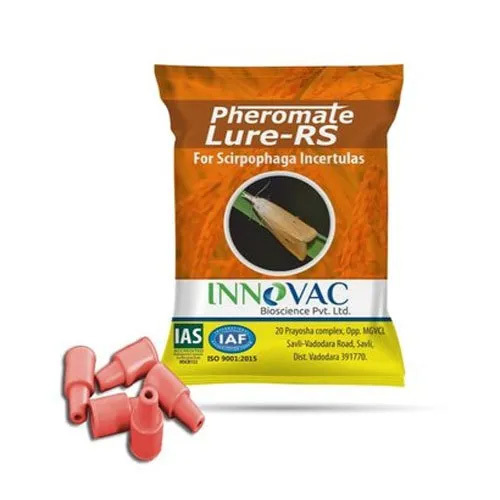Pheromone Lures For Scirpophaga Incertulas
Product Details:
- Type Pesticides
- Material Rubber
- Usage Agriculture
- Click to View more
Pheromone Lures For Scirpophaga Incertulas Price And Quantity
- 9 INR/Unit
- 5000 Unit
Pheromone Lures For Scirpophaga Incertulas Product Specifications
- Rubber
- Agriculture
- Pesticides
Pheromone Lures For Scirpophaga Incertulas Trade Information
- Cash Advance (CA)
- 100000 Unit Per Day
- 5 Days
- Western Europe Central America Middle East Eastern Europe South America Asia North America Australia Africa
- All India
Product Description
You can take the following actions to employ pheromone lures for Scirpophaga incertulas:
1. Identify the ideal deployment window: When used during the adult moth's flight phase, pheromone lures work best. Depending on your location and the particular species present, the timing may change. Entomologists or local agricultural extension organisations can advise you on the best timing for your region.
2. Choose a good lure: Find pheromone lures made especially for Scirpophaga incertulas. These lures, which frequently come in the shape of tiny dispensers or traps made of rubber or plastic and imbued with pheromones, are sold commercially.
3. Strategically place the lures: Arrange the lures in your rice field in accordance with the suggested instructions. In general, you should put them in the region at regular intervals, preferably at plant height. The manufacturer's recommendations for lure density and spacing should be followed.
4. Keep an eye on the traps: Sticky or pheromone-baited traps are frequently employed in conjunction with pheromone lures. The male moths drawn by the pheromone lures will be caught in these traps. Check and count the caged moths frequently to keep track of population numbers and evaluate the success of your control measures.
5. If necessary, adjust the deployment: You can adjust the quantity and location of the lures as necessary based on the trapping data and observation of crop damage. You could use fewer lures if the trapping findings show a population decline. On the other hand, if the population is still high, more lures might be required.
Scirpophaga incertula pheromone lures are frequently employed in conjunction with other control strategies such cultural practises, biological control agents, and, if necessary, targeted insecticide applications as part of an integrated pest management (IPM) strategy.
Because Scirpophaga incertulas can produce numerous generations during a growing season, treating this pest demands a thorough strategy. To handle Scirpophaga incertula infestations efficiently, speak with local agricultural specialists or extension agencies for solutions that are suited to your location and rice crop.
Other Products in 'Pheromone Trap' category
 |
INNOVAC BIOSCIENCE PVT. LTD.
All Rights Reserved.(Terms of Use) Developed and Managed by Infocom Network Private Limited. |
 English
English Spanish
Spanish French
French German
German Italian
Italian Chinese (Simplified)
Chinese (Simplified) Japanese
Japanese Korean
Korean Arabic
Arabic Portuguese
Portuguese
















